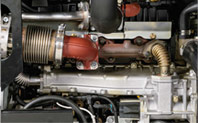1. Cooled Exhaust Gas Recirculation (CEGR) System

The pollutant NOx is formed when oxygen and nitrogen in the air react at high temperatures, like those found in an engine's cylinders. The CEGR system captures a small amount of the engine's exhaust, cools it to a lower temperature and diverts it back into the engine's cylinders. This makes fewer oxygen and nitrogen molecules available to chemically create NOx. An electronically controlled switching valve optimizes the CEGR system's operation, ensuring maximum engine performance at all times. This optimized performance has the added benefit of higher power density, which increases both engine torque and fuel efficiency.
Benefits:
Fewer NOx emissions, improved engine power, greater fuel efficiency.